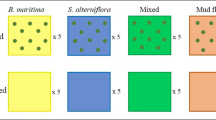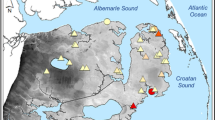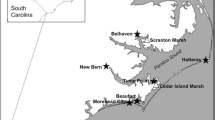Abstract
Salt marsh ecosystems provide many critical ecological functions, yet they are subject to considerable disturbance ranging from direct human alteration to increased inundation due to climate change. We assessed emergent salt marsh plant characteristics in the Tuckerton Peninsula, a large expanse (~ 2000 ha) of highly inundated habitat along the southern New Jersey coast, USA. Key salt marsh plant parameters were monitored in the heavily grid-ditched northern segment, Open Marsh Water Management (OMWM) altered central segment, and the shoreline altered southern segment of the peninsula in the summer months of 2011 and 2013. Plant species composition and three metrics of abundance and structure (maximum canopy height, percent areal cover, and shoot density) were examined among marsh segments, along transects within segments, seasonally by month and between years. Despite seasonal or annual variability, the northern segment of the marsh differed in plant species composition from the central and southern segments. This difference was partly due to greater percent areal cover in the northern segment of upper marsh species such as Spartina patens and Distichlis spicata. S. patens also exhibited higher shoot densities in the northern segment than the central segment. Despite the higher abundance of upper marsh species, marsh surface elevations were lower in the northern segment than in the central or southern segments, suggesting the influence of altered hydrology due to human activities. Understanding current variation in the emergent salt marsh vegetation along the peninsula will help inform future habitat change in other coastal wetlands of New Jersey and the mid-Atlantic region subject to natural and anthropogenic drivers.



Similar content being viewed by others
References
Able, K.W., and S.M. Hagan. 2000. Effects of common reed (Phragmites australis) invasion on marsh surface macrofauna: response of fishes and decapod crustaceans. Estuaries 23: 633–646.
Adam, P. 1990. Saltmarsh ecology. Cambridge: Cambridge University Press.
Adam, P. 2015. Saltmarshes. In Encyclopedia of estuaries, ed. M.J. Kennish, 515–535. Dordrecht: Springer.
Adam, P., M.D. Bertness, A.J. Davy, and J.B. Zedler. 2008. Saltmarsh. In Aquatic ecosystems: trends and global prospects, ed. N. Polunin, 157–171. Cambridge: Cambridge University Press.
Bertness, M.D., and A.M. Ellison. 1987. Determinants of pattern in a New England salt marsh plant community. Ecological Applications 57: 129–147.
Bertness, M.D., and P.J. Ewanchuk. 2002. Latitudinal and climate-driven variation in the strength and nature of biological interactions in New England salt marshes. Oecologia 132: 392–401.
Bilkovic, D.M., and M.M. Mitchell. 2017. Designing living shoreline salt marsh ecosystems to promote coastal resilience. In Living shorelines: the science and management of nature-based coastal protection, ed. D.M. Bilkovic, M.M. Mitchell, M.K. La Peyre, and J.D. Toft, 293–316. Boca Raton: CRC Press.
Bilkovic, D.M., M. Mitchell, P. Mason, and K. Duhring. 2016. The role of living shorelines as estuarine habitat conservation strategies. Coastal Management 44: 161–174.
Boorman, L.A. 1992. The environmental consequences of climatic change on British salt marsh vegetation. Wetlands Ecology and Management 2 (1–2): 11–21.
Boorman, L.A. 1999. Salt marshes–present functioning and future change. Mangroves and Salt Marshes 3 (4): 227–241.
Chapman, V.J. 1974. Salt marshes and salt deserts of the world. Lehr: J. Cramer.
Day, J.W., R.R. Christian, D.M. Boesch, A. Yanez-Arancibia, J. Morris, R.R. Twilley, L. Naylor, L. Schaffner, and C. Stevenson. 2008. Consequences of climate change on the ecogeomorphology of coastal wetlands. Estuaries and Coasts 31: 477–491.
Durey, H., T. Smith, and M. Carullo. 2012. Restoration of tidal flow to salt marshes. In Tidal marsh restoration: a synthesis of science and management, ed. C.T. Roman and D.M. Burdick, 165–172. Washington, DC: Island Press. doi:10.5822/978-1-61091-229-7_10.
Elsey-Quirk, T., and S.C. Adamowicz. 2016. Influence of physical manipulations on short-term salt marsh morphodynamics: examples from the North and Mid-Atlantic Coast, USA. Estuaries and Coasts 39 (2): 423–439.
Emery, N.C., P.J. Ewanchuk, and M.D. Bertness. 2001. Competition and salt-marsh plant zonation: stress tolerators may be dominant competitors. Ecology 82: 2471–2485.
Ewanchuk, P.J., and M.D. Bertness. 2004. Structure and organization of a northern New England salt marsh plant community. Journal of Ecology 92 (1): 72–85.
Ford, M.A., D.R. Cahoon, and J.C. Lynch. 1999. Restoring marsh elevation in a rapidly subsiding salt marsh by thin-layer deposition of dredged material. Ecological Engineering 12: 189–205.
Gedan, K.B. 2015. Mosquito ditching. In Encyclopedia of estuaries, ed. M.J. Kennish, 448–449. Dordrecht: Springer.
Gedan, K.B., A.H. Altieri, and M.D. Bertness. 2011. Uncertain future of New England salt marshes. Marine Ecology Progress Series 434: 229–237.
Hartig, E.K., V. Gornitz, A. Kolker, F. Mushacke, and D. Fallon. 2002. Anthropogenic and climate-change impacts on salt marshes of Jamaica Bay, New York City. Wetlands 22: 71–89.
IPCC (Intergovernmental Panel on Climate Change). 2007. Climate change 2007: the science basis. Contribution of Working Group 1 to the Fourth Assessment Report. Cambridge: Cambridge University Press.
IPCC (Intergovernmental Panel on Climate Change). 2014. Climate change 2014: synthesis report. Contribution of Working Groups I, II and III to the Fifth Assessment Report. Cambridge: Cambridge University Press.
Kennish, M.J. 2001. Coastal salt marsh systems in the U.S.: a review of anthropogenic impacts. Journal of Coastal Research 17: 731–748.
Kennish, M.J., B.M. Fertig, and G. Petruzzelli. 2012. Emergent vegetation: NERR SWMP tier 2 salt marsh monitoring in the Jacques Cousteau National Estuarine Research Reserve. Technical Report. New Brunswick: National Estuarine Research Reserve Program (NOAA), Institute of Marine and Coastal Sciences, Rutgers University 22 pp.
Kennish, M.J., A. Spahn, and G.P. Sakowicz. 2014a. Sentinel site development of a major salt marsh system in the Mid-Atlantic region. Open Journal of Ecology 4: 77–86. doi:10.4236/oje.2014.43010.
Kennish, M.J., M.S. Meixler, G. Petruzzelli, and B. Fertig. 2014b. Tuckerton Peninsula salt marsh system: a sentinel site for assessing climate change effects. Bulletin of the New Jersey Academy of Science 58 (2): 1–5.
Kennish, M.J., R.G. Lathrop Jr., A. Spahn, G.P. Sakowicz, and R. Sacatelli. 2016. The JCNERR sentinel site: research and monitoring applications. Bulletin of the New Jersey Academy of Science 61 (1): 1–8.
Kent, D.M. 1994. Applied wetlands science and technology. Boca Raton: Lewis Publishers.
King, S.E., and J.N. Lester. 1995. The value of salt marsh as a sea defence. Marine Pollution Bulletin 30 (3): 180–189.
Kirwan, M.L., and J.P. Megonigal. 2013. Tidal wetland stability in the face of human impacts and sea-level rise. Nature 504: 53–60.
Kirwan, M.L., A.B. Murray, and W.S. Boyd. 2008. Temporary vegetation disturbance as an explanation for permanent loss of tidal wetlands. Geophysical Research Letters 35: L05403. doi:10.1029/2007GL032581.
Lathrop, R.G. 2000. New Jersey land cover change analysis project. Final Report. New Brunswick: Center for Remote Sensing and Spatial Analysis, Rutgers University, 38 pp.
Lathrop, R.G., Jr., and J.A. Bognar. 2001. Habitat loss and alteration in the Barnegat Bay region. Journal of Coastal Research, Special Issue 32: 212–228.
Levine, J.M., J.S. Brewer, and M.D. Bertness. 1998. Nutrients, competition and plant zonation in a New England salt marsh. Journal of Ecology 86 (2): 285–292.
Meixler, M.S., K.K. Arend, and M.B. Bain. 2005. Fish community support in wetlands within protected embayments of Lake Ontario. Journal of Great Lakes Research 31: 188–196.
Mendelssohn, I.A., and N.L. Kuhn. 2003. Sediment subsidy: effects on soil-plant responses in a rapidly submerging coastal salt marsh. Ecological Engineering 21: 115–128.
Miller, R.G., R.E. Kopp, B.P. Horton, J.V. Browning, and A.C. Kemp. 2013. A geological perspective on sea-level rise and its impacts along the U.S. mid-Atlantic coast. Earth’s Future 1: 3–18. doi:10.1002/2013EF000135.
Mitsch, W.J., and J.G. Gosselink. 2015. Wetlands. 5th ed. Hoboken: Wiley.
Moody, J., D. Kreeger, E. Reilly, K. Collins, L. Haaf, and M. Maxwell-Doyle. 2017. Rapid vulnerability assessment of tidal wetlands using the Marsh Futures approach to guide strategic municipal projects. Report No. 17-03. Wilmington: Partnership for the Delaware Estuary, 69 pp.
Moore, K. 2011. NERRS SWMP biomonitoring protocol: long-term monitoring of estuarine submersed and emergent vegetation communities. Technical Report Series. Silver Spring: National Estuarine Reserve System, NOAA 35 pp.
Pennings, S.C., M.B. Grant, and M.D. Bertness. 2005. Plant zonation in low latitude salt marshes: disentangling the roles of flooding, salinity and competition. Journal of Ecology 93 (1): 159–167.
Peterson, G.W., and R.E. Turner. 1994. The value of salt marsh edge vs interior as a habitat for fish and decapod crustaceans in a Louisiana tidal marsh. Estuaries 17 (1): 235–262.
Rella, A., J. Miller, and E. Hauser. 2017. An overview of thee living shorelines initiative in New York and New Jersey. In Living shorelines: the science and management of nature-based coastal protection, ed. D.M. Bilkovic, M.M. Mitchell, M.K. La Peyre, and J.D. Toft, 65–86. Boca Raton: CRC Press.
Strayer, D.L., and S.E.G. Findlay. 2010. Ecology of freshwater shore zones. Aquatic Sciences 72 (2): 127–163.
Strayer, D.L., S.E. Findlay, D. Miller, H.M. Malcom, D.T. Fischer, and T. Coote. 2012. Biodiversity in Hudson River shore zones: influence of shoreline type and physical structure. Aquatic Sciences 74 (3): 597–610.
Sutton-Grier, A.E., K. Wowk, and H. Bamford. 2015. Future of our coasts: the potential for natural and hybrid infrastructure to enhance the resilience of our coastal communities, economies, and ecosystems. Environmental Science and Policy 51: 137–148.
Temmerman, S., P. Meire, T.J. Bouma, P.M. Herman, T. Ysebaert, and H.J. De Vriend. 2013. Ecosystem-based coastal defence in the face of global change. Nature 504 (7478): 79–83.
Tiner, R.W. 1999. Wetland indicators. Boca Raton: Lewis Publishers.
Tong, C., J.J. Baustian, S.A. Graham, and I.A. Mendelssohn. 2013. Salt marsh restoration with sediment-slurry application: effects on benthic macroinvertebrates and associated soil-plant variables. Ecological Engineering 51: 151–160.
Velinsky, D., M. Enache, D. Charles, C. Sommerfield, and T. Belton. 2011. Nutrient and ecological histories in Barnegat Bay, New Jersey. Technical report. Lewes: Academy of Natural Sciences, University of Delaware 91 pp.
Vincent, R.E., D.M. Burdick, and M. Dionne. 2013. Ditching and ditch-plugging in New England salt marshes: effects on hydrology, elevation, and soil characteristics. Estuaries and Coasts 36 (3): 610–625.
Wolfe, R.J. 2005. Open marsh water management: a review of system designs and installation guidelines for mosquito control and integration in wetland habitat management. Proceedings of the 92nd Annual Meeting, New Jersey Mosquito Control Association, pp. 3–14.
Acknowledgements
This is Contribution Number 5527 of the Department of Marine and Coastal Sciences, Rutgers University. Grant funding in support of this work was provided by the National Estuarine Research Reserve System, National Oceanic and Atmospheric Administration, Silver Spring, MD (award numbers NA10NOS4200198 and NA12NOS4200152). Many thanks to Kyle Oschell for assisting with the literature search for this study and to Karen Grace-Martin for assistance with the statistical analyses.
Author information
Authors and Affiliations
Corresponding author
Additional information
Communicated by Charles Simenstad
Appendix
Appendix
Non-metric multidimensional scaling (NMDS) plot showing 90 field plots sampled in the Tuckerton Peninsula salt marsh in September 2011 and September 2013, grouped by year. Plant species included DISSPI (Distichlis spicata), LIMCAR (Limonium carolinianum), SALSPP (Salicornia spp.), SPAALT (Spartina alterniflora), and SPAPAT (Spartina patens). Final stress was 0.069
Rights and permissions
About this article
Cite this article
Meixler, M.S., Kennish, M.J. & Crowley, K.F. Assessment of Plant Community Characteristics in Natural and Human-Altered Coastal Marsh Ecosystems. Estuaries and Coasts 41, 52–64 (2018). https://doi.org/10.1007/s12237-017-0296-0
Received:
Revised:
Accepted:
Published:
Issue Date:
DOI: https://doi.org/10.1007/s12237-017-0296-0





